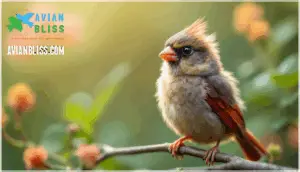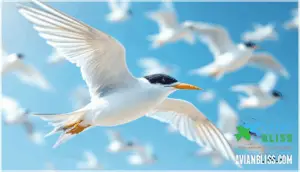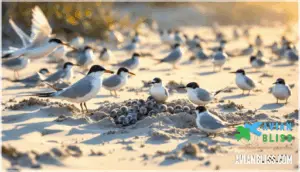This site is supported by our readers. We may earn a commission, at no cost to you, if you purchase through links.
 A flash of black and white skims just above the water, and you might miss North America’s smallest tern. The least tern measures barely nine inches from bill to tail, yet its yellow bill and sharp forked tail make identification simple once you know what to look for.
A flash of black and white skims just above the water, and you might miss North America’s smallest tern. The least tern measures barely nine inches from bill to tail, yet its yellow bill and sharp forked tail make identification simple once you know what to look for.
These coastal specialists nest on open sandy beaches and gravel bars, where their tiny scraped nests blend into the bare substrate. Their survival depends on undisturbed nesting areas, which have become scarce as human activity expands along shorelines and waterways.
Table Of Contents
- Key Takeaways
- Least Tern Identification and Description
- Least Tern Habitat and Distribution
- Least Tern Behavior and Life Cycle
- Least Tern Diet and Foraging Habits
- Least Tern Conservation and Threats
- Frequently Asked Questions (FAQs)
- Why is the Least Tern endangered?
- What does Least Tern mean?
- What is the difference between a Least Tern and a common tern?
- How many Least Tern are left?
- What is the average lifespan of Least Terns?
- How do Least Terns communicate with each other?
- Are there any known diseases affecting Least Terns?
- What is the migration pattern of Least Terns?
- How do least terns communicate with each other?
- What predators threaten least tern populations?
- Conclusion
Key Takeaways
- The least tern is North America’s smallest tern at just nine inches long, identifiable by its bright yellow bill, black-and-white head pattern, and sharply forked tail.
- These birds nest in vulnerable open areas like sandy beaches and gravel bars, making them highly susceptible to habitat loss from coastal development, human disturbance, and predation.
- The interior population was listed as endangered in 1985 and delisted in 2021 after conservation efforts increased numbers to 18,000 individuals, though California’s subspecies remains federally endangered.
- Least terns have adapted to human-altered environments by nesting on gravel rooftops and industrial buildings when natural sites are unavailable, showing flexibility driven by necessity rather than preference.
Least Tern Identification and Description
The Least Tern is a small seabird that you can identify by its distinctive features and compact size.
This guide covers the physical traits that set it apart from other terns. You’ll learn what to look for when spotting this species in the field.
Physical Characteristics
You’ll recognize the Least Tern right away by its trim build and sleek proportions. This distinctive small seabird shows sharp features that help with identification:
- Bill Coloration: Bright yellow bill during breeding season
- Wing Morphology: Long pointed wings built for agile flight
- Tail Shape: Forked tail creates a lithe profile
The black-and-white head pattern and slender body make the Least Tern unmistakable. Sexual dimorphism is minimal between males and females.
Size and Measurements
When you compare the Least Tern to other birds, it sits right between a Tree Swallow and a Forster’s Tern in overall size. Sexual dimorphism is minimal, with both sexes showing similar size ranges.
| Measurement | Range |
|---|---|
| Length | 8.3-9.1 in (21-23 cm) |
| Weight | 1.3-1.9 oz (36-54 g) |
| Wingspan | 18.9-20.9 in (48-53 cm) |
| Shape | Slender and sharp |
These measurements provide accuracy when distinguishing this species from similar terns.
Distinctive Field Marks
The Least Tern’s bright yellow bill and black-and-white head pattern make it easy to spot even from a distance. When you observe these birds in flight, watch for these key identification features:
- Wing shape: Slender and sharply pointed for agile flight
- Tail fork: Distinctive V-shaped notch at the tail tip
- Bill shape: Needle-thin and dagger-like for catching small fish
The overall size and shape appear compact and aerodynamic, creating a sharp color pattern against the sky.
Differences From Similar Species
You’ll find that separating Least Terns from other small terns takes a bit of practice, but size is your first clue. Forster’s Tern is noticeably larger and heavier with a thicker bill morphology.
When habitat overlap occurs along coasts, check the color pattern: adult Least Terns show that bright yellow bill while Forster’s displays orange-red.
Flight patterns differ too—Least Terns use quicker wingbeats and more erratic movements during foraging.
Least Tern Habitat and Distribution
The Least Tern lives in specific places along coasts and inland waterways. You’ll find this small seabird in areas that match its nesting and feeding needs.
Let’s look at where these terns make their home and how they move with the seasons.
Preferred Coastal and Inland Habitats
If you’re looking for this small seabird, you’ll need to keep your eyes on sandy beaches, sandbars, and river islands where the ground stays open and flat. Least tern habitat selection focuses on sparse vegetation and sandy nesting substrates along coastal habitat zones.
You’ll also find them in inland expansion areas near rivers and lakes. Habitat loss and restoration efforts now include gravel rooftops where least tern nesting actions reflect human-altered environments.
Geographic Range
Across much of North America, you can track least terns during breeding distribution along coastal areas and inland rivers from California to the Atlantic coast. Migration patterns take them south to Central and South America for wintering locations.
Regional differences show the interior population faces severe habitat loss while coastal areas see range expansion. Wintering areas stretch from Mexico through northern South America where these birds forage along tropical coastlines.
In Delaware, least tern colonies are monitored by the Division of Fish and Wildlife.
Adaptation to Human-Altered Environments
When beaches and gravel rooftops replace natural sandbars, least terns have shown considerable flexibility in choosing nesting sites. You’ll find them adapting to urban nesting across coastal development zones where habitat loss threatens traditional grounds. Here’s how they’re managing:
- Rooftop colonies on industrial and commercial buildings provide safe alternatives to disturbed beaches
- Gravel roof surfaces mimic natural substrate conditions for egg laying and chick protection
- Disturbance tolerance has improved as birds adjust to human activity in populated areas
- Conservation strategies now include installing nesting platforms on suitable structures
- Ongoing conservation efforts monitor these adaptive populations to track long-term viability
This flexibility offers hope, but human pressures remain constant. You’re seeing real adaptation—not preference—driven by necessity.
Seasonal Movements and Migration
Every autumn, least terns abandon their breeding grounds by late August, triggering a dramatic migration to tropical wintering areas. These small seabirds travel up to 4,000 kilometers along established migration patterns, with interior populations moving south via river systems toward the Gulf of Mexico.
Grouping intensifies at stopover locations along major rivers and coastal zones within 200 kilometers of the Gulf. Juveniles depart later than adults, facing higher mortality during southbound migration.
By March, survivors return north, with breeding grounds occupied again by late May, completing an annual cycle that defines least tern distribution across continents. Their populations have been impacted by habitat loss, leading to conservation concerns.
Least Tern Behavior and Life Cycle
Least terns have fascinating behaviors shaped by their life at sea. They’re colony nesters that work together for breeding success.
Let’s explore how they find mates, build nests, raise their young, and prepare fledglings for life on the water.
Social Structure and Colony Nesting
Least terns don’t nest alone—they breed in colonies that can range from a handful of pairs to several hundred birds huddled together on the same stretch of beach or rooftop. This colony structure creates distinct dynamics that shape how these birds survive and thrive together.
- Nesting density varies depending on habitat and food availability, with birds sometimes packed tight enough to defend shared territory from predators and intruders.
- Social hierarchy emerges naturally within breeding colonies, where experienced pairs often secure prime nesting spots while younger birds must adapt to available space.
- Cooperative defense strengthens as the colony collectively protects nests and chicks from threats, creating safety through numbers and coordinated alarm calls.
This pair bonding and group structure allow least terns to optimize reproductive success in vulnerable open habitats.
Mating and Courtship Displays
To find a mate, least terns put on quite the show—and it all starts with a fish. Males perform aerial displays, climbing high into the air with a small fish gripped in their bill. They circle and dive, catching the female’s attention through these dramatic flights.
Back on the ground, courtship feeding is a highlight—the male offers the fish to the female, strengthening their pair bond. This ritual repeats throughout the breeding season, synchronizing the colony’s reproductive timing and guaranteeing successful mate selection across the breeding ground.
Nesting Sites and Nest Construction
Once the pair bonds are sealed through courtship feeding, least terns waste no time finding the right spot to nest. These birds are colony nesters, gathering in groups on open ground or rooftops. They show strong site fidelity, returning to the same nesting colony year after year. The nest itself is minimal—just a shallow scrape in sand or gravel, sometimes lined with pebbles or debris. Eggs are buff to pale green with dark blotches. Most pairs lay 1–3 eggs.
- Open ground and gravel roofs serve as primary nest site options
- Shallow scrape construction requires minimal nesting materials
- Colony site selection concentrates birds for safety and efficiency
- Site fidelity guarantees consistent use of proven nesting locations
- Nest scrape characteristics protect eggs from water and predators
Incubation, Parenting, and Fledging
Both parents share the hard work of keeping the eggs warm, though the female usually takes the lead in those early days. The incubation period lasts about three weeks. Once chicks hatch, both parents hunt tirelessly to feed growing young. Chick development happens fast—fledglings leave the nest in just 3–4 weeks. Young terns must learn to hover and dive before they’re truly independent. Fledgling survival depends on strong parental care and abundant small fish nearby.
| Stage | Duration | Key Development |
|---|---|---|
| Incubation | 21 days | Egg coloration protects from sun |
| Hatching | 1 day | Chicks emerge from eggs |
| Chick Care | 3-4 weeks | Rapid growth with parental feeding |
| Fledging | 1 week | Young learn diving and hovering |
| Independence | Ongoing | Fledgling survival improves with practice |
Least Tern Diet and Foraging Habits
Least terns are skilled hunters that catch their food from the water and air. You’ll find they eat small fish most often, but they also consume crustaceans, insects, and other small prey.
Let’s look at what they eat and how they hunt.
Primary Food Sources
You’ll find small fish at the heart of a Least Tern’s diet, along with crustaceans and insects that vary depending on where and when they’re feeding. In coastal areas, fish consumption dominates their intake. These prey items fuel their survival:
- Small fish provide essential protein for adults and growing chicks
- Crustacean variety offers key nutrients during breeding season
- Insect importance increases inland, supplementing their diet
Mollusk intake and marine worm significance round out their food sources.
Foraging Techniques and Adaptations
Watching a Least Tern hunt is like seeing a tiny aerial acrobat at work—they hover above the water with rapid wingbeats before diving headfirst to snatch prey just below the surface. Their prey detection relies on sharp vision, while hover-feeding allows precise positioning.
You’ll see them plunge diving to catch fish or grabbing insects mid-air. This diet plasticity and foraging efficiency help them adapt to available food resources in different habitats.
Seasonal and Regional Diet Variation
What a Least Tern eats depends on where it nests and what time of year you’re watching—coastal birds lean heavily on small fish while inland populations switch to more insects and freshwater prey.
Prey availability drives these regional differences in diet. During breeding season, their nutritional needs increase, so feeding activity intensifies.
Climate impact and seasonal changes affect what’s accessible, which shows their striking diet plasticity across different environments.
Least Tern Conservation and Threats
The Least Tern faces serious challenges that threaten its survival across North America. Understanding these threats and the efforts to protect this small seabird helps you appreciate why conservation matters.
Here’s what you need to know about the status of Least Terns and the work being done to keep their populations stable.
Endangered Status and Legal Protection
Federal protections for the least tern have shifted over time. The interior population earned endangered status in 1985 and was delisted in 2021 after hitting recovery benchmarks. California’s subspecies remains federally endangered since 1970.
Regional ranks vary—New York lists it as threatened while Connecticut calls it critically imperiled.
Protective legislation like the Migratory Bird Treaty Act shields all populations. Enforcement mechanisms require permits for habitat work, and conservation partnerships across 18 states support ongoing endangered species protection.
Human Impacts on Nesting Areas
Beach disturbance and urban development rank as top environmental threats to least tern colonies. Coastal development impacts force birds onto less-protected sites, where predation increases sharply. Human foot traffic causes colony disruption and habitat destruction through nest abandonment.
Habitat alteration from construction removes natural nesting areas, pushing terns onto gravel rooftops.
Conservation efforts now fence breeding zones to reduce these pressures on vulnerable populations.
Conservation Efforts and Management
Active habitat restoration and predator control programs led to the Interior Least Tern’s removal from the Endangered Species List in 2021 after populations reached 18,000 individuals. Targeted predator management at sites like Camp Pendleton increased reproductive success.
Federal agencies manage 80% of critical habitat through conservation agreements. Public stewardship programs use fencing and volunteer patrols to protect colonies.
Recovery cost $1.72–2 million over ten years, funding habitat enhancement and enforcement to reverse population decline from habitat destruction.
Ongoing Monitoring and Community Involvement
Citizen scientists and trained volunteers track nearly every breeding pair along the Atlantic coast each summer, creating a network of eyes that spans thousands of miles of shoreline. These Volunteer Conservation Programs conduct annual census counts and contribute to Predator Monitoring Programs.
Public Education efforts through Stewardship Programs help beachgoers understand colony boundaries.
Data Collection feeds directly into Habitat Restoration plans, making sure conservation decisions reflect real-time population trends.
Frequently Asked Questions (FAQs)
Why is the Least Tern endangered?
The interior population faces habitat loss from dam construction and river channelization. Human disturbance at nesting sites remains a critical threat.
Climate change affects coastal breeding areas through rising sea levels and increased storm frequency.
Predation threats from gulls, foxes, and domestic animals contribute to population decline factors.
What does Least Tern mean?
The name refers to this bird’s ranking as the smallest tern species in North America. "Least" indicates its diminutive size compared to other terns, while "tern" describes the seabird family it belongs to.
What is the difference between a Least Tern and a common tern?
Distinguishing these birds comes down to size and color. Least Terns are distinctly smaller with bright yellow bills and a compact build. Common Terns are larger with red-orange bills and longer wings.
Both species hunt in similar coastal areas but differ in calls and breeding plumage details.
How many Least Tern are left?
Population estimates for breeding pairs vary by region. Surveys from 1985–1995 found about 3,000 breeding pairs on Long Island alone.
The interior U.S. population remains endangered, though conservation efforts have helped species recovery in some areas since protective legislation began in
What is the average lifespan of Least Terns?
Avian species in coastal habitats usually survive between seven and twelve years in the wild. Least Tern longevity records show similar patterns, though mortality causes from predation and habitat loss affect age determination.
These lifespan factors influence population impact across breeding colonies.
How do Least Terns communicate with each other?
You’ll recognize Least Terns by their sharp calls and aerial displays.
They use high-pitched vocalizations during courtship and alarm calls to warn the colony of threats.
Chicks communicate through persistent begging calls when hungry.
Are there any known diseases affecting Least Terns?
Avian diseases and tern parasites can affect these coastal birds. Common issues include Newcastle disease and avian influenza. Coastal pollution impacts their immune response.
Disease monitoring helps protect endangered species facing multiple threats to bird species.
What is the migration pattern of Least Terns?
Migratory birds travel thousands of miles between their breeding grounds and wintering areas each year. Small terns make impressive journeys from coastal North America to Central and South America.
They follow migration routes along shorelines and major river systems, using stopover locations to rest and refuel before continuing south in fall and north in spring.
How do least terns communicate with each other?
Least terns communicate through sharp calls and visual displays. Adults use harsh "kip" notes to signal threats or defend territories.
During courtship, males perform aerial displays while carrying fish.
Chicks make begging calls when hungry.
What predators threaten least tern populations?
Avian predators like gulls and crows raid nests for eggs and chicks. Mammalian threats include foxes, raccoons, and cats that target colonies. Reptilian dangers come from snakes.
Habitat vulnerability increases predation risk, making predator management and monitoring essential conservation strategies for this endangered species.
Conclusion
Like a canary in a coal mine, the least tern signals the health of our coastal ecosystems. When these nine-inch birds thrive, it indicates beaches and waterways remain intact enough to support specialized wildlife.
Your awareness matters now more than ever. Each undisturbed nesting site and protected shoreline gives these smallest terns a fighting chance.
Their recovery hinges on collective action—from beach managers to beachgoers who respect posted areas during breeding season. Watch for that distinctive yellow bill and forked tail, and you’ll witness resilience in miniature form.
- https://macaulaylibrary.org/photo/37792271
- https://animaldiversity.org/accounts/Sterna_antillarum/
- https://www.nps.gov/caco/learn/nature/the-least-tern.htm
- https://pmc.ncbi.nlm.nih.gov/articles/PMC3797504/
- https://www.federalregister.gov/documents/2021/01/13/2020-28192/endangered-and-threatened-wildlife-and-plants-removal-of-the-interior-least-tern-from-the-federal











